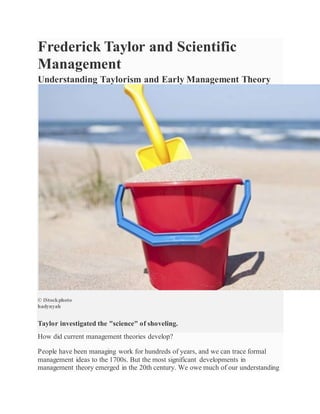
Frederick taylor and scientific management
- 1. Frederick Taylor and Scientific Management Understanding Taylorism and Early Management Theory © iStockphoto hadynyah Taylor investigated the "science" of shoveling. How did current management theories develop? People have been managing work for hundreds of years, and we can trace formal management ideas to the 1700s. But the most significant developments in management theory emerged in the 20th century. We owe much of our understanding
- 2. of managerial practices to the many theorists of this period, who tried to understand how best to conduct business. Historical Perspective One of the earliest of these theorists was Frederick Winslow Taylor. He started the Scientific Management movement, and he and his associates were the first people to study the work process scientifically. They studied how work was performed, and they looked at how this affected worker productivity. Taylor's philosophy focused on the belief that making people work as hard as they could was not as efficient as optimizing the way the work was done. In 1909, Taylor published "The Principles of Scientific Management." In this, he proposed that by optimizing and simplifying jobs, productivity would increase. He also advanced the idea that workers and managers needed to cooperate with one another. This was very different from the way work was typically done in businesses beforehand. A factory manager at that time had very little contact with the workers, and he left them on their own to produce the necessary product. There was no standardization, and a worker's main motivation was often continued employment, so there was no incentive to work as quickly or as efficiently as possible. Taylor believed that all workers were motivated by money, so he promoted the idea of "a fair day's pay for a fair day's work." In other words, if a worker didn't achieve enough in a day, he didn't deserve to be paid as much as another worker who was highly productive. With a background in mechanical engineering, Taylor was very interested in efficiency. While advancing his career at a U.S. steel manufacturer, he designed workplace experiments to determine optimal performance levels. In one, he experimented with shovel design until he had a design that would allow workers to shovel for several hours straight. With bricklayers, he experimented with the various motions required and developed an efficient way to lay bricks. And he applied the scientific method to study the optimal way to do any type of workplace task. As such, he found that by calculating the time needed for the various elements of a task, he could develop the "best" way to complete that task. These "time and motion" studies also led Taylor to conclude that certain people could work more efficiently than others. These were the people whom managers should seek to hire where possible. Therefore, selecting the right people for the job was another important part of workplace efficiency. Taking what he learned from these workplace
- 3. experiments, Taylor developed four principles of scientific management. These principles are also known simply as "Taylorism". Four Principles of Scientific Management Taylor's four principles are as follows: 1. Replace working by "rule of thumb," or simple habit and common sense, and instead use the scientific method to study work and determine the most efficient way to perform specific tasks. 2. Rather than simply assign workers to just any job, match workers to their jobs based on capability and motivation, and train them to work at maximum efficiency. 3. Monitor worker performance, and provide instructions and supervision to ensure that they're using the most efficient ways of working. 4. Allocate the work between managers and workers so that the managers spend their time planning and training, allowing the workers to perform their tasks efficiently. Critiques of Taylorism Taylor's Scientific Management Theory promotes the idea that there is "one right way" to do something. As such, it is at odds with current approaches such as MBO (Management By Objectives), Continuous Improvement initiatives, BPR (Business Process Reengineering), and other tools like them. These promote individual responsibility, and seek to push decision making through all levels of the organization. FindingThis Article Useful? You can learn another 269 team management skills, like this, by joining the Mind Tools Club. Find Out More
- 4. The idea here is that workers are given as much autonomy as practically possible, so that they can use the most appropriate approaches for the situation at hand. (Reflect here on your own experience – are you happier and more motivated when you're following tightly controlled procedures, or when you're working using your own judgment?) What's more, front line workers need to show this sort of flexibility in a rapidly-changing environment. Rigid, rules-driven organizations really struggle to adapt in these situations. Teamwork is another area where pure Taylorism is in opposition to current practice. Essentially, Taylorism breaks tasks down into tiny steps, and focuses on how each person can do his or her specific series of steps best. Modern methodologies prefer to examine work systems more holistically in order to evaluate efficiency and maximize productivity. The extreme specialization that Taylorism promotes is contrary to modern ideals of how to provide a motivating and satisfying workplace.
- 5. Where Taylorism separates manual from mental work, modern productivity enhancement practices seek to incorporate worker's ideas, experience and knowledge into best practice. Scientific management in its pure form focuses too much on the mechanics, and fails to value the people side of work, whereby motivation and workplace satisfaction are key elements in an efficient and productive organization. Key Points The Principles of Taylor's Scientific Management Theory became widely practiced, and the resulting cooperation between workers and managers eventually developed into the teamwork we enjoy today. While Taylorism in a pure sense isn't practiced much today, scientific management did provide many significant contributions to the advancement of management practice. It introduced systematic selection and training procedures, it provided a way to study workplace efficiency, and it encouraged the idea of systematic organizational design.